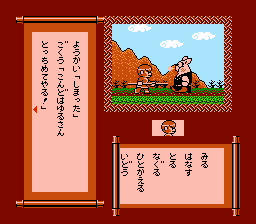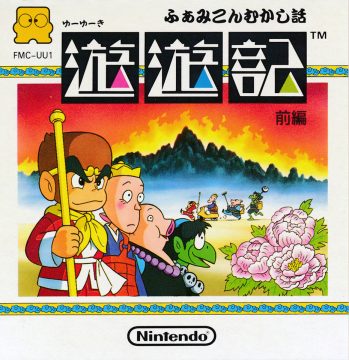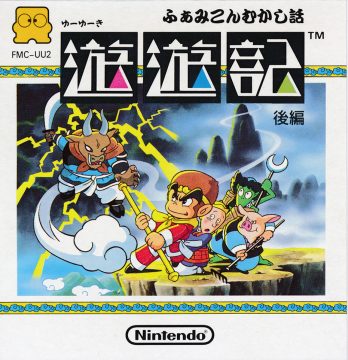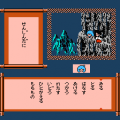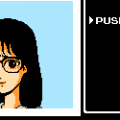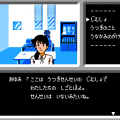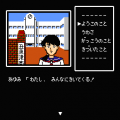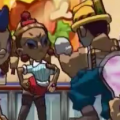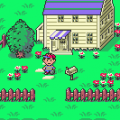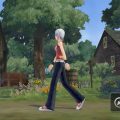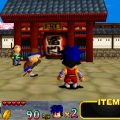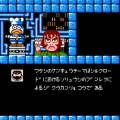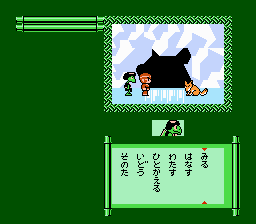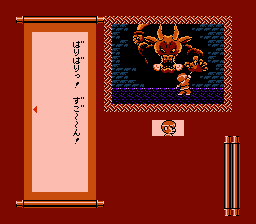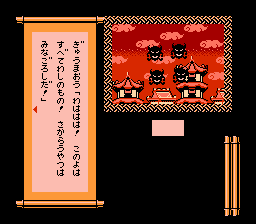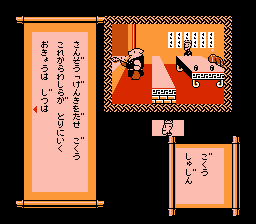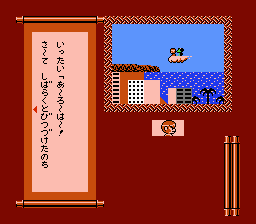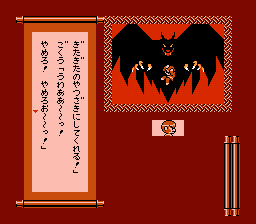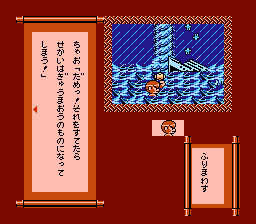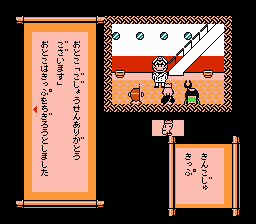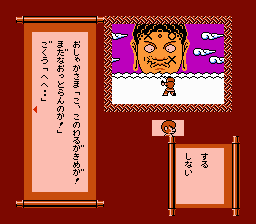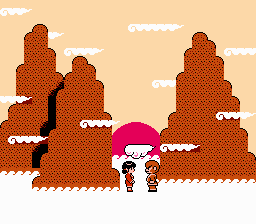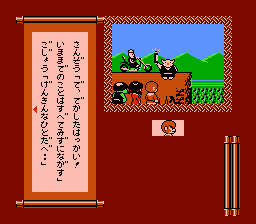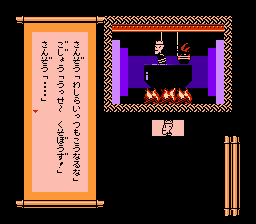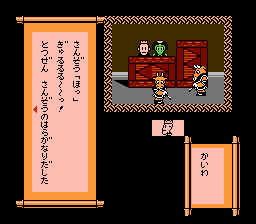After having based their first ever adventure game, Shin Onigashima (1987) on Japanese folklore and subsequently honing their ADV craft by the new thematic directions of Tokimeki High School (1987) and the two Famicom Detective Club games (1988 & 1989), Nintendo and PaxSoftnica returned to their Famicom Fairytales series in the fall of 1989. Rather than continuing adapting Japanese tales, the developers based the second entry in the series, Famicom Mukashibanashi: Yuuyuuki, on the famous Chinese story “The Journey to the West”. This 16th century book is considered one of the Four Classic Chinese Novels and tells the story of a band of characters tasked by a Buddha to travel to India to collect Holy Scriptures. One of the protagonists of the tale is the Monkey King Sun Wukong (Son Gokuu in Japanese) who can probably be said to be one of the most famous characters in the history of East Asian literature and is instantly recognizable by his signature strength, flying cloud and magic extendable staff. The 100 chapter novel is extensive in size and content, but after the initial parts wherein the main characters are established, it becomes highly episodic in its depiction of the different perils the party encounter on their journey. This format lends itself well to reinterpretations, and many translations and adaptations are based on an abridged selection of chapters. Being such an old tale, “The Journey to the West” has been told and retold innumerable times, but is for Westerners probably most famous for being the basis of Dragon Ball (1984). A very popular Japanese TV series called Saiyuuki (西遊記, the Japanese pronunciation of the Chinese title) was broadcast in 1978-80 that focused specifically on Son Gokuu, so the source material was very much part of the zeitgeist of when this game was made.
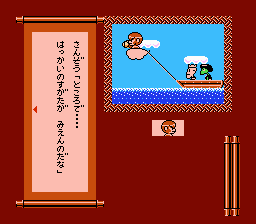
Like its predecessor, Yuuyuuki is a comedic retelling of the source material, but where Shin Onigashima took a light-hearted and only occasionally silly tone, Yuuyuuki leans heavily towards parody, gags and anachronisms. This is indicated already in the title: the second kanji of “The Journey to the West” (西遊記), 遊, meaning “play” is doubled in Yuuyuuki (遊遊記), thus indicating that this will be a playful, imaginative take on the story. Rather than being heroic adventurers, the main travelers are depicted as selfish, lazy and greedy and their personal motivations get them in a lot of trouble. The game begins from the perspective of the original character Chao, an orphan living in a village in China who spends her days reading romance novels. One night she sees a shooting star and makes a wish to meet a boyfriend. The star turns out to be a comet that crashes in the nearby woods, and as Chao tries to put out the fire by pouring water on the glowing rock, the comet cracks open to reveals a monkey (a riff on how Son Wukong was born from a stone egg in the original novel). She names him Gokuu and begins to teach him human language and manners. One day, the hand of the Buddha Shaka-sama (Japanese for the historical Shakamuni Buddha, i.e. Siddhartha Gautama after his enlightenment) reaches down from the sky and takes Gokuu to the Heavens. The Buddha is furious with Gokuu for returning to Earth and imprisons him in a rock in the middle of a Chinese desert. There, Gokuu eats a magical peach and remembers that he is the Monkey King and that together with Bull Demon King (Gyuumaou) he once led a rampage on the Heavens which resulted in their banishment to outer space. The Buddha appears to Chao and gives her a quest to retrieve a magical mallet, convincing her that doing so will allow her to meet Gokuu again.
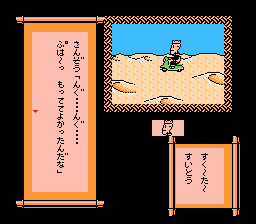
A few years later, the Buddhist monk Sanzou flees his hometown during a siege by the Bull Demon King’s minions. In the original novel, the monk rides on a dragon that has shape-shifted himself to horse, but in Yuuyuuki the monk instead rides a green scooter named Ryuukichi (possibly meaning “Lucky Dragon”, but as the name is only spelled in hiragana and not kanji, multiple interpretations are possible). Riding out into the desert, the monk eventually stumbles upon the rock where Gokuu is imprisoned. The Buddha appears to Sanzou and tells him to partner up with the monkey and travel to India to retrieve the Holy Sutra of “How to Live Comfortably for the Rest of Your Life”. The content of the scripture quickly convinces the lazy, unscrupulous monk to take on the quest. The monkey, unwilling at first, is convinced when the Buddha puts a metal headband on the monkey’s head and teaches Sanzou a spell to make it contract and cause infernal headaches. On their journey to India they join forces with a greedy, mischievous pig named Hakkai who speaks in Osaka-dialect and can transform himself into anything, and a lazy kappa called Gojou that can telepathically read the inner thoughts of people. The journey takes them to various different locations, intersecting with Chao’s adventures and battling a number of demons, before eventually reaching India.
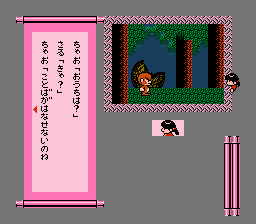
Like Shin Onigashima before it, Yuuyuuki came on two disks (Zenpen and Kouhen) and uses a traditional-looking layout with vertical, left-to-right writing and text boxes that resemble scrolls. A couple of features have been polished since the last game, such as increased text and scroll animations, an option to manually restart the chapter, and how the game no longer returns to the start of the last chapter when a save game is loaded. The Change Character command returns and each of the five playable characters now have their own background colour to clearly mark who you are controlling. The different protagonists have different abilities and most chapters have at least one section in which you need to switch between characters to solve the puzzles. The puzzle design follows ADV traditions closer than Shin Onigashima did, meaning that there is more focus on dialogue and character abilities than inventory and object interactions. As such, Yuuyuuki is a much easier game than the at times obtuse Shin Onigashima, and the general balance between storytelling and puzzles is much better tuned here in the sequel.
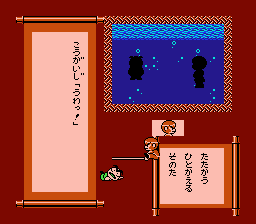
The character design has taken a step towards the cartoony since the last game, and is brought to life with colorful and expressive animations that are full of slapstick and other funny little moments. A recurring gag is how the characters literally keep breaking the fourth wall by jumping out of the confinements of the illustration screen and run around among the menu and text boxes. This is established already in the first chapter when a scared Chao hides behind the border of the screen during her first meeting with Gokuu. Another new addition are the battle mini-games where Gokuu fights various enemies (often triggered by his short temper and violent nature). The mini-games are generally very simple and vary from hitting targets at the right timing, to avoiding projectiles. You can die in these sections, but you generally get to restart at the previous scene and at not the chapter beginning, if you do.
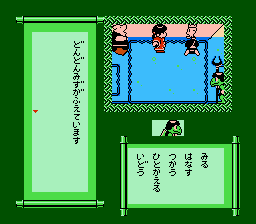
Despite being visually similar and both being based on classical epic storytelling, the two first games in Famicom Mukashibanashi series feel very different. While Shin Onigashima in its own right nails the feeling of a traditional fairy-tale adventure, Yuuyuuki feels more wild and epic, magical, and unpredictable, with deeper developed characters and internal conflicts in the party. A large part of this comes from the fact that Yuuyuuki is a significantly more verbose game, and the larger length of the script allows for much more characterization and development. However, the irreverent, silly tone and tons of anachronisms of Yuuyuuki might be dialed a tad too high for some tastes. If you go into this game expecting Shin Onigashima’s style of adaptation, the steadily increasing number of anachronisms (the scooter, a cruise ship, a modern day Hawaii and Tokyo, elevators, helicopters, TV screens) might be a let-down. However, if you give yourselves to the silly whims of game and make your way past the initial, story-establishing chapters, you will find an highly entertaining story that will draw you in just by wanting to see what surprises it will throw at you next, if it so is a karaoke performance on a boat so awful that the audience punches the singer through a wall and sinks the ship, a self-proclaimed beauty queen who is just a giant head with arms and legs, a hidden trap-door found after eating a fridge full of food and accidentally knocking a bottle of milk over on the floor boards, a quiz show about Western fairytales, a sudden cameo of the main characters from Shin Onigashima, a defacing of the literal face of a God with a permanent marker, having Hakkai the pig transform into boat tickets to cheat your way onto a cruise ship only for it to backfire when the steward wants to punch holes in the tickets, and so on.
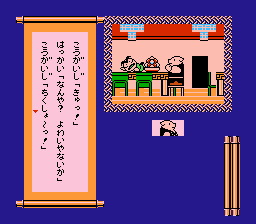
Yuuyuuki was one of the last games Nintendo developed for the FDS (only Backgammon, Time Twist, CluClu Land were released after it) and it was the last FDS game to be advertised on TV (a 30 second spot showing the characters flying around the world visiting the different locations of the game). Interestingly, Yuuyuuki has never been re-released, despite how its siblings Shin Onigashima and Famicom Detective Club have been kept alive by various GBA, Virtual Console and Switch ports. There has never been an official statement as to why this is, but Japanese video game wiki Game Catalogue speculates that there may be copyright issues regarding an uncredited ghost writer, and that some references to song lyrics would need to be removed from the game.
Despite the lack of ports, Gokuu and Chao have had cameo appearances in Kirby’s Dream Land 2 (JP version only) and Kirby’s Dream Land3, and appear in Smash Bros Ultimate as spirit power-ups. Yuuyuuki designer Keiji Terui has told in an interview that PaxSoftnica had plans for a third Famicom Mukashibanashi game on the FDS themed around One Thousand and One Nights, but the plans were changed and eventually became Time Twist – a time travel game with almost zero likelihood to ever be re-released due to the, for an official Nintendo product, atypical degree of family-unfriendly content (including Hitler, Ku Klux Klan and a demonically possessed Baby Jesus). While it is clear that Shin Onigashima is the historically more important game, Yuuyuuki possesses a creativity and sense-of-humor that deserves to be remembered. The lack of a fan translation makes this game difficult to access for players that cannot read Japanese, but there is an annotated walkthrough on NinDB that summarizes the major scenes for those who are interested in learning more about what happens in the game.
Screenshot comparisons and cameos
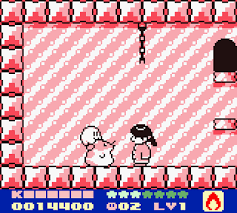
Chao appeared as a hidden character in the Japanese release of Hoshi no Kirby 2 (1995) for the Gameboy. She only appears at random, and finding her is required to reach 100% completion.
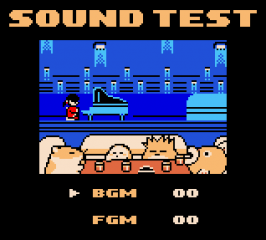
![D:\Spel\Screenshots\Famicom Mukashibanashi\02 - Yuyuki\Selected screens\Famicom Mukashibanashi - Yuuyuuki [Merged, works in fceux230]-881.png](http://www.hardcoregaming101.net/wp-content/uploads/2021/12/d-spel-screenshots-famicom-mukashibanashi-02-yu-6.png)
Hidden sound test screen in Hoshi no Kirby 2 (GB) referring to one of the scenes on the cruise ship in Yuuyuuki (FDS).
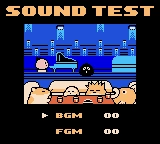
In the international version (Kirby’s Dream Land 2) all instances of Chao were changed to different characters, since Yuuyuuki was not released in the West.
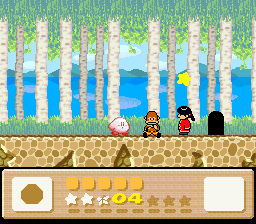
![D:\Spel\Screenshots\Famicom Mukashibanashi\02 - Yuyuki\All screens\Famicom Mukashibanashi - Yuuyuuki [Merged, works in fceux230]-74.png](http://www.hardcoregaming101.net/wp-content/uploads/2021/12/d-spel-screenshots-famicom-mukashibanashi-02-yu-8.png)
Chao and Gokuu also appeared in the 1997 sequel Hoshi no Kirby 3 (SFC), and remained unchanged in its international release Kirby’s Dream Land 3 (SNES). Gokuu’s sprite comes from a scene early in Yuuyuuki when Chao is teaching Gokuu table manners.
![C:\Users\Daniel\Dropbox\Private backup (non-work related)\HG101\Famicom Mukashibanashi\Selected screens\Famicom Mukashibanashi - Yuuyuuki [Merged, works in fceux230]-1668.png](http://www.hardcoregaming101.net/wp-content/uploads/2021/12/c-users-daniel-dropbox-private-backup-non-work-r-14.png)
A few members of the cast of Shin Onigashima (the previous game in the series) make a short appearance in one of the later chapters of Yuuyuuki.
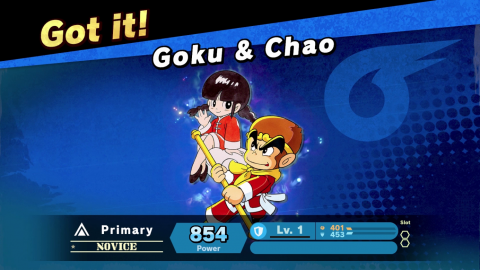
Chao and Gokuu appeared as a collectible power-up in Smash Bros. Ultimate (Switch, 2018)
References and further reading
A previous HG101 text on this game has appeared in:
Kalata, K. & Hubbard D. (2017) HG101 Presents: The Complete Guide to the Famicom Disk System
An annotated walkthrough with story summaries:
https://nindb.net/nes/yuyuki/guide1.html
TV commercial (the last to feature a FDS game):
https://www.youtube.com/watch?v=j_J_FRjaUeg
Promotional materials for the games:
https://disk-kun.com/handbills/fc/yuuyuuki-zenpen
https://disk-kun.com/handbills/fc/yuuyuuki-kouhen
Entry on the game at the Japanese Game Catalogue wiki (ゲームカタログ@Wiki), and the source of some of the rumours as to why the game has never been re-released
https://w.atwiki.jp/gcmatome/pages/3467.html
Interview with designer Keiji Terui with in which he mentions the plans for a third Famicom Mukashibanashi game based on One Thousand and One Nights game (that eventually changed theme and became Time Twist)
http://oni.skr.jp/terui.html
